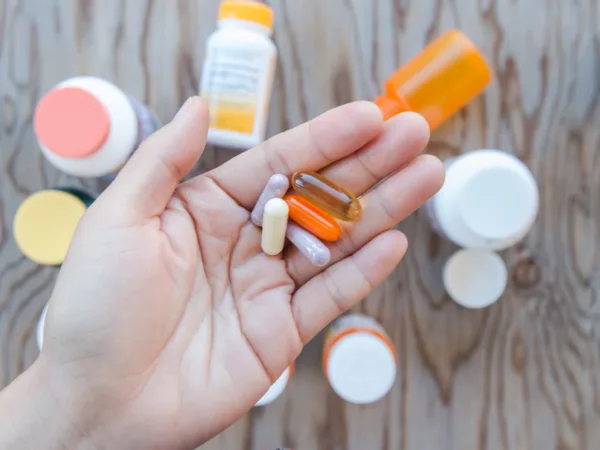Despite Australia being one of the sunniest countries on earth, a 2022 study by Curtin University found that 9 out of 10 Australians have a Vitamin D deficiency. And across the ditch, studies suggest that around 1 in 2 New Zealand adults also have a deficiency.
Vitamin D is a fat-soluble vitamin that promotes the absorption of calcium, helps to regulate bone growth and supports the normal functioning of our immune system. Exposure of our skin to sunlight is our most predominant source of Vitamin D by a wide margin, and although we can get some Vitamin D from food sources such as liver, fatty fish, fish oils, egg yolk and butter, our modern diets mean food does not contribute to a meaningful source of Vitamin D unless it is fortified.
In a country plagued by high skin cancer rates, many Aussies are wisely choosing to limit their sun exposure in an attempt to protect their skin. While this helps to reduce the risks of skin cancer, it, unfortunately, can also have a negative effect on one's Vitamin D levels. Low sun exposure and changes in season can significantly impact the skin’s production of Vitamin D. As well as this, as we age our skin has a reduced capacity to produce Vitamin D, and higher intakes are required from the age of 50 onwards to ensure Vitamin D sufficiency is maintained. As such, boosting our Vitamin D is crucial to our overall health.

There is an overwhelming body of scientific evidence that demonstrates that the fortification of food with Vitamin D or taking Vitamin D3 supplements is an effective way to prevent low Vitamin D levels. However, there are some conflicting views in the scientific community as to whether the two forms of Vitamin D are equally effective at this.
Vitamin D occurs in two forms, which are both beneficial to human health but are found in very different contexts.
- Vitamin D2 (or ergocalciferol) is mainly found in UV-light exposed mushrooms, which is one of the few food sources of vegan vitamin D. Ergocalciferol can be produced industrially from ergosterol, which is extracted from the cell membranes of yeasts or fungi and is then exposed to UVB light and further purification processes.
- Vitamin D3 (cholecalciferol), on the other hand, is produced by the action of sunlight on the skin and is also found in foods such as oily fish and eggs. It has been shown to have both better bioavailability and a better half-life, meaning it stays in circulation in the body for longer. Vitamin D3 has historically been synthesised from lanolin obtained from the wool of sheep, meaning that plant-based consumers have been unable to take supplements of this important vitamin. However, these days animal-free Vitamin D3 forms do exist, from sources including lichen, algae, and pine phytosterols.
Recent studies have repeatedly shown that Vitamin D3 is more efficacious at raising Vitamin D concentrations in the blood than Vitamin D2. In fact, some studies have suggested that Vitamin D3 raises Vitamin D levels in the blood 87% more than Vitamin D2! This may be due to the relative binding affinity of the different forms of Vitamin D and their metabolites to Vitamin D binding protein in plasma. Vitamin D2 has a similar but not identical molecular structure to Vitamin D3. This difference leads to the lower binding of Vitamin D2 to the Vitamin D binding protein, as well as an increase in removal of Vitamin D2 from circulation and the reduced conversion of Vitamin D2 to the active form of Vitamin D.

There are, however, rare cases where Vitamin D2 may be the better choice for supplementation. For example, some trials suggest that Vitamin D2 may be better at treating immune issues in patients who are undergoing steroid therapy. However, research results vary, and various elements can impact the efficacy of Vitamin D supplementation, including the food product being used. Given this, it is hard to be completely certain that Vitamin D3 is more efficacious than Vitamin D2. And despite the differences between the two forms of Vitamin D, both are metabolised in quite similar ways.
When you're thinking about whether to use Vitamin D2 or D3 in your application, there are some important factors to consider apart from efficacy. Do you need plant-based and vegan-suitable Vitamin D, or will an animal-origin source suffice? Have you considered cost-in-use, since typically plant-origin sources are often more costly? Are you going to be making any positioning claims with your product?
Vitamin D deficiency is increasingly common, and not only in Australia. Estimates suggest that around 1 billion people globally struggle with Vitamin D deficiencies. Vitamin D supplementation is a crucial part of fighting these deficiencies, and emerging evidence is beginning to suggest that Vitamin D2 and D3 may not be equal. However, the science is not conclusive on this point as of yet. What we do know for certain is that Vitamin D supplementation is an excellent way to address harmful deficiencies.
At Hawkins Watts, we have an ever-expanding range of health and nutrition ingredients available, including plant-derived, vegan-friendly Vitamin D3 in oil and powder formats. With a team of highly qualified food technologists and a specialist health and nutrition division, we can work together with you to find the best solutions for your supplement or functional food projects.
Please
reach out to our expert in NZ, Sandra Murray, if you have any queries: sandra@hawkinswatts.com
Sources
Vitamin D2 and D3: what’s the difference and which should you take? (theconversation.com)
Vitamin D2 vs. D3: What’s the Difference? (healthline.com)
Vitamin D3: Benefits, Sources, Deficiency, and Risks (verywellhealth.com)
NHMRC Vitamin D monograph: https://www.eatforhealth.gov.au/nutrient-reference-values/nutrients/vitamin-d
Dietitians Australia: https://dietitiansaustralia.org.au/health-advice/vitamin-d
Vitamin D - NZ Nutrition Foundation
https://www.curtin.edu.au/news...
Fu L., Yun F., Oczak M., Wong B.Y.L., Vieth R., Cole D.E.C. Common genetic variants of the Vitamin D binding protein (DBP) predict differences in response of serum 25-hydroxyVitamin D [25(OH)D) to Vitamin D supplementation. Clin. Biochem. 2009;42:1174–1177. doi: 10.1016/j.clinbiochem.2009.03.008
Waterhouse M., Tran B., Armstrong B.K., Baxter C., Ebeling P.R., English D.R., Gebski V., Hill C., Kimlin M.G., Lucas R.M., et al. Environmental, personal, and genetic determinants of response to Vitamin D supplementation in older adults. J. Clin. Endocrinol. Metab. 2014;99:E1332–E1340. doi: 10.1210/jc.2013-4101.
Shraim, R.; MacDonnchadha, C.; Vrbanic, L.; McManus, R.; Zgaga, L. Gene-Environment Interactions in Vitamin D Status and Sun Exposure: A Systematic Review with Recommendations for Future Research. Nutrients 2022, 14, 2735. https://doi.org/10.3390/nu14132735
Tripkovic L, Lambert H, Hart K, Smith CP, Bucca G, Penson S, Chope G, Hyppönen E, Berry J, Vieth R, LanhamNew S. Comparison of Vitamin D2 and Vitamin D3 supplementation in raising serum 25-hydroxyVitamin D status: a systematic review and meta-analysis. Am J Clin Nutr. 2012 Jun;95(6):1357-64. doi: 10.3945/ajcn.111.031070. Epub 2012 May 2. PMID: 22552031; PMCID: PMC3349454.
Shieh A, Chun RF, Ma C, Witzel S, Meyer B, Rafison B, Swinkels L, Huijs T, Pepkowitz S, Holmquist B, Hewison M, Adams JS. Effects of High-Dose Vitamin D2 Versus D3 on Total and Free 25-HydroxyVitamin D and Markers of Calcium Balance. J Clin Endocrinol Metab. 2016 Aug;101(8):3070-8. doi: 10.1210/jc.2016-1871. Epub 2016 May 18. PMID: 27192696; PMCID: PMC4971338.




